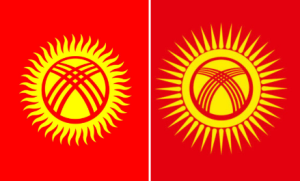As 2024 dawned in Kyrgyzstan, a new flag fluttered over Bishkek. To the untrained eye, it may look mostly the same but the rays on the sun are a little straighter – even if the priorities of the Kyrgyz government remain wavering.
On November 29, Kyrgyzstan’s parliament passed the first of three required readings of a bill first proposed in September that called for changing the design of the Kyrgyz flag. The introduction of the bill sparked a backlash among the public, not that most Kyrgyz lawmakers cared much. On December 20, without discussion, the parliament adopted the bill following two readings that were conducted at once.
In a speech that RFE/RL’s Kyrgyz Service reported had gone essentially “unnoticed” by the parliament, one deputy, Nurzhigit Kadyrbekov, opposed the bill by pointing to the fact that “the most powerful state in the world,” the United States, has a flag that “looks like a mattress” and yet it has not been changed. (Note: The U.S. flag has been changed 26 times since 1777, adding new stars for new states accepted into the union.) Kadyrbekov also said that the Democratic Party’s mascot, a donkey, has not been changed either — suggesting perhaps that an ass is not the greatest of mascots. These were not the most compelling arguments.
More importantly, Kadyrbekov noted that the flag-change proposal had generated discord among the public and alluded to the arrest of a young man – Aftandil Zhorobekov – who was detained on December 8 after calling for protests against the flag-change plan. A small rally did go ahead on December 9 in Bishkek, while more opposition was voiced online.
Colleen Wood detailed the proposed changes last month when the first reading passed. She noted that this was “not the first time Kyrgyzstan’s lawmakers have tried to change the flag” and that the proposed changes were, in comparison to earlier initiatives, rather minor.
The Kyrgyz flag retains its colors and general structure: a yellow tunduk – the iconic top of a yurt – inside a sun with forty rays against a red background. The sun’s rays are now straight, rather than wavy, and somewhat separated from the circle. The tunduk has four slats crossing four now, rather than three crossing three.
Administratively, the adoption of the new flag will likely be gradual. Official documents, the law states, will be valid until their expiration dates and existing images of the national flag elsewhere – such as on car tags – will be able to be used until the relevant state bodies make plans for their replacement. Elsewhere, such as government flagpoles, the new design is appearing already.
During the People’s Kurultai on December 15-16, President Sadyr Japarov admitted that the initiative to change the flag was his. The Kurultai is an ancient tradition resurrected as a conveniently unelected political forum in the 2020 referendum.
It’s worth ending on this section from Wood’s article last month and the suggestion that maybe the Kyrgyz parliament, and government, has more important things to work on:
When local media outlet Kaktus conducted street interviews in Bishkek back in October, people not only said they prefer the original design, but that they think this whole bill is a distraction from actual societal problems. Respondents cited rising taxes, inflation, domestic violence, and crumbling roads.
“I don’t get it. If we change the flag, then everyone will be fed, they won’t shut off electricity in the winter, houses will be warm, and food will be cheaper?” Avazbek Amanbekov, a world class champion kickboxer, posted on his Instagram stories. “Are we really going to compete under a different flag now?”

































